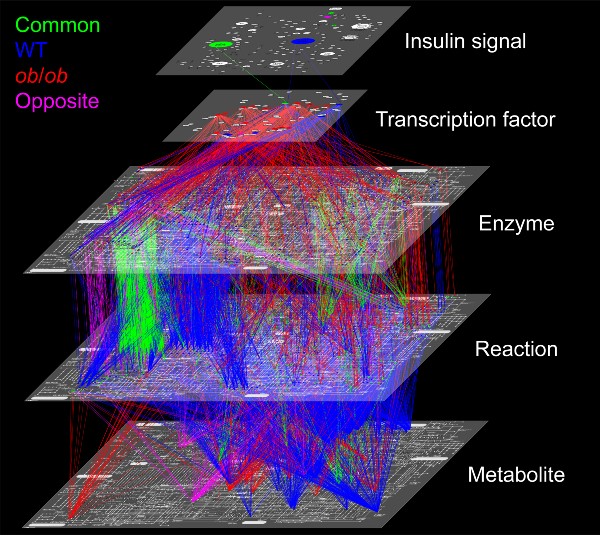
The trans-omic network includes regulatory pathways that are specific to obese mice and those specific to healthy mice. Color coding highlights pathways that respond to glucose only in normal-weight mice (WT, blue), only obese mice (ob/ob, red), pathways in common (green), and pathways that react in opposite ways in obese and normal-weight mice (pink). © Toshiya Kokaji, CC-BY
Healthy cells and cells with Type 2 diabetes use completely different pathways to manage blood sugar levels, according to results from a study in mice. Researchers used a trans-omic approach, combining data from genes (transcriptomics) and metabolites (metabolomics) to identify and connect the many separate processes involved in responding to glucose.
"Many regulatory pathways for diabetes are already well known. What we have done is map the total landscape of diabetes regulation," said Professor Shinya Kuroda, leader of the Systems Biology Lab at the University of Tokyo. Kuroda's team previously mapped the different cell signaling pathways activated in response to high or low concentrations of insulin.
"We expected only small differences between the healthy and diabetes regulatory network, but we found they were totally different," said Kuroda.
Obese mice lack most of the rapid response to glucose found in healthy metabolism, instead relying on much slower methods like changing gene expression.
Building a trans-omic network of glucose response
After eating a meal or sugary drink, insulin triggers cells to allow glucose molecules to move from the blood into cells, where glucose is broken down and converted into energy. In Type 2 diabetes, cells become insensitive to insulin, so glucose remains in the blood causing prolonged high blood sugar levels known as hyperglycemia.
Decades of diabetes research have revealed that many signaling pathways become active when glucose is inside the cell. Many of those paths involve enzymes and small molecules called metabolites, which are themselves products of metabolic pathways.
Kuroda's team studied healthy mice and a strain of mouse with a genetic mutation that causes the mice to overeat and develop diabetes in adulthood. All mice drank sugary water and then researchers waited between 20 minutes to four hours before taking blood samples and dissecting their liver. The liver is a major site of glucose metabolism in both mice and humans.
Researchers used a wide range of experiments to identify molecules that changed in response to glucose.






